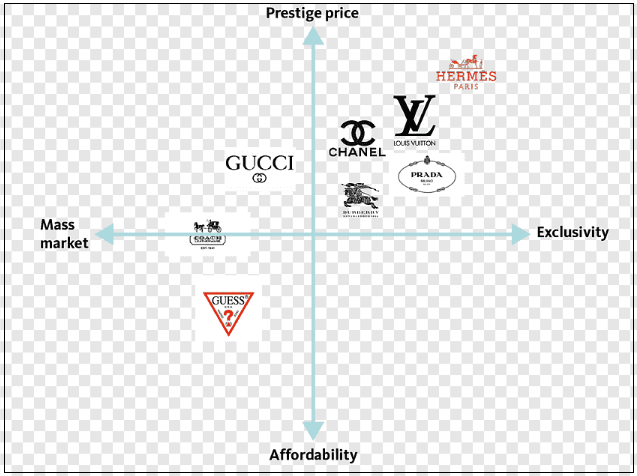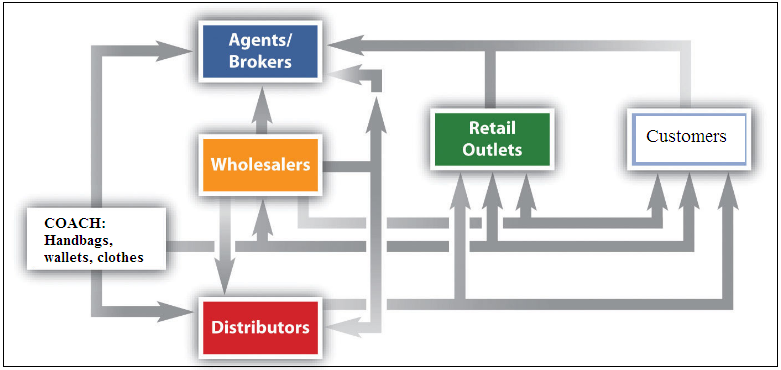Introduction
Coach has relied on effective and sustainable practices to become one of the leading handbags and fashion brands in the United States. It delivers stunning products that are characterized by elegance, quality, and fashion. This company’s success is attributable to the use of quality leather materials and its long tradition for style and design. The firm’s products are priced slightly below some of the leading brands in the country, such as Gucci, Hermes, and Louis Vuitton. In the modern business times, proper pricing, omnichannel, and business strategies would be recommendable if Coach is to compete with the leading luxury brands in the country.
Concept of the Product Line
The notion of product line refers to the inclusion of two or more goods that are marketed in a specific region using a single brand name. In most cases, such products would be attributed to a single company. For Coach, this concept remains instrumental towards supporting business operations and ensuring that the anticipated goals are eventually realized. Relying on the same brand name, Coach has established a number of lines that are critical in supporting the marketing effort (Kusumawardhani et al. 639). These include designer handbags, menswear, shoes, wallets, and clothing. Through the use of these product lines, the firm continues to target luxury shoppers and individuals who are interested in fashion.
With a vast product line, Coach remains keen to rely on the same brand name to maximize the identification and subsequent selection of the available items. After purchasing and using a specific product from Coach, the customer can go further to sample another item (Wang and John 148). This practice is usually possible when the individual is convinced that the brand is associated with elegance, quality, and usability. This tactic has remained instrumental towards supporting the marketing strategy, attracting more potential customers, and eventually maximizing the level of recorded profits.
Product line pricing is a common initiative that Coach takes into consideration in an effort to achieve its business aims. This approach entails the separation of most of the specific products into diverse categories and using differentiated prices for them. The initiative is pursued in such a way that the targeted customers can develop different perceptions about each of the product line (Kamis et al., 717). Those who consider one item would become convinced that the others lines are capable of delivering the same quality and experience. By promoting a sense of discrimination in the pricing process, the customers might be compelled to pay more for diverse products, thereby making it possible for Coach to record increased profits and turnover.
With a vast product line, this company succeeds in informing the customers about the available items and their respective prices. The customers will make timely decisions regarding which product to purchase. This decision allows them to consider whether they would be willing to buy other product lines or not (Kamis et al., 719). From the company’s recent trends, the model might be discouraging more customers since the pricey items might not be in tandem with the clients’ perception of luxury.
Effect of Pricing on Customer Perceptions
Over the years, Coach has remained a reputable brand whose products resonate with the changing needs of many customers in the country. However, more individuals focusing on luxury brands have realized that Coach’s products are expensive while not delivering the promises associated with luxury items, such as Gucci. In an effort to get value for money, majority of the American customers have been keen to associate themselves with products from other local handbag manufacturers or incur additional costs for luxury products (Lai and Xian 1279). This scenario has triggered a new trend whereby the percentage of handbags marketed by Coach is lower. The end result is that the company has continued to record reduced sales and profits.
From a psychological perspective, many consumers tend to assume that higher prices would be associated with quality and high-end goods. The use of higher prices for Coach’s handbags and other product lines encouraged more people to acquire them from different outlets (see Fig. 1). The approach ensures that their prices were higher in comparison with those of the existing or immediate competitors (Lai and Xian 1280). However, they were lower than those of the leading luxury brands, such as Gucci. This strategy encouraged more people to purchase such products since they gave them a sense of luxury or contentment.

In terms of positioning, Coach has gone further to consider outlet stores for a wide range of its items. However, the company relied on lower prices for most of the products to attract more customers and eventually record positive results. The reality was that majority of the customers became unhappy since they realized that specific Coach’s outlets were characterized by higher prices. The same was not the case for most of the retail outlets in the country, such as TJ Maxx (Litman 7). Consequently, more customers became concerned and disinterested in purchasing the company’s products. Additionally, the effort to focus on individuals interested in occasional luxury purchase has helped keep the volume of sales much lower. The strategy to focus on high-end earners has proved to be counterproductive since more people are keen to acquire other products from immediate competitors.
The presented positioning map reveals that Gucci tries to target the wider mass market while relying on its prestige pricing approach. Coach, on the other hand, offers reduced prices while targeting on more potential customers (see Fig. 1). Guess is a leading company that targets the existing mass market using affordable products. From this analysis, it is evident that Coach continues to experience increasing competition from different players in the sector (Litman 8). A renewed approach to positioning and market segmentation could be plausible if Coach is to overcome the recorded challenges and eventually maximize its overall profits
Coach’s Multi-Channel Structure
Coach relies on the use of a multichannel structure to achieve its business aims. This model is designed in such a way that it allows the company to have several marketing and sales channels. This approach has made it possible for the company to identify additional segments based on the targeted objectives. The targeted customers are able to identify some of the available outlets whereby they can identify and purchase the relevant products. For instance, the organization has indirect wholesales whose roles include delivering most of the handbags and apparels to third-party retailers (Litman 7). The specific retailers focus on the needs of the consumers in different regions across the globe. For example, the company has opened retail outlets in China, North Africa, and Japan.
Customers can identify some of the available products and purchase them trough the organization’s online store, catalogues, and website. To improve the established multichannel, Coach has shipping centers in upscale areas whereby it meets the demands of most of the customers (Litman 9). The organization has been keen to increase the number of store outlets in an effort to maximize sales (see Fig. 2). Continuous monitoring and analyses are powerful approaches that the organization put into consideration to address obstacles and improve performance.
Unfortunately, the promoted multichannel structure has the potential to deliver a wide range of conflicts. For instance, the promoted product line pricing model reduces the faith of most of the customers after realizing that different prices are promoted (Wang and John 146). The multichannel approach is characterized by additional expenses and stakeholders who reduce the overall profits the company records. In some cases, the company is compelled to promote a standardized model that might not be in accordance with the promoted business model. The use of the multichannel model is problematic when two of the involved marketers or channels compete and offer the presented product at different prices (Wang and John 149). The involved players might find it hard to agree on the best prices, thereby triggering confusion and reduction in the recorded sales.

The current challenges affecting Coach calls for an effective structure to attract more customers and improve their experiences. The concept of omnichannel seems plausible whereby different coordinated physical outlets, mobile applications, social media networks, and e-commerce. This marketing approach entails the cooperation of different channels to maximize the experience of the customers (Yeğin and Ikram 11598). The individuals will be exposed to a common brand, interact with it, and become repeat customers. Coach will rely on the existing physical stores and integrate its online platform to attract more customers. The customers will be able to identify the right outlets and consider the offered prices.
The proposed omnichannel is capable of guiding the targeted customers to find the relevant physical or online outlet based on their personal needs. The leveraging of technology will ensure that some of the conflicts associated multichannel systems are addressed. Online platforms will allow customers to get real-time information while maximizing pricing parity. The individuals will engage with Coach’s products and consider how they can achieve their potential. The model will ensure that more customers are able to access the intended handbags and clothes from the available offline and online channels (Chen and Chi 903). People using different handheld devices, website, and offline stores will experience a customer-focused approach that can deliver positive results. The increasing number of young people relying on the use of mobile-based applications and social media will help drive overall sales while at the same time improving marketing coordination.
Conclusion
The completed discussion has identified Coach as one of the upcoming brands in North America, China, and Japan. The company is presenting experiencing stiff competition from both low-priced and luxury brands across the globe. This challenge has led to reduced sales and subsequent profits for the company. The company’s use of positioning and marketing approaches has continued to support the promoted multichannel system. The recorded conflicts have led to reduced profitability in the wider fashion sector. The consideration of omnichannel marketing could help mitigate most of the recorded challenges and ensure that the company maximizes the overall customer experience. This achievement will increase sales, meet the demands of more buyers, and eventually improve performance.
Works Cited
Chen, Yini, and Ting Chi. “How Does Channel Integration Affect Consumers’ Selection of Omni-Channel Shopping Methods? An Empirical Study of U.S. Consumers.” Sustainability, vol. 13, no. 16, 2021, pp. 8983-9011.
Kamis, Arasinah, et al. “Women’s Handbag Innovation: Design, Comfort, and Safety Features.” International Journal of Innovation, Creativity and Change, vol. 11, no. 10, 2020, pp. 711-726.
Kusumawardhani, Amanda P., et al. “Consumer Preference of Choosing Branded Bag.” International Journal of Research and Review, vol. 8, no. 3, 2021, pp. 637-645,
Lai, Huatong, and Zijun Xian. “The Success of Luxury Goods Branding in China: A Case Study of Gucci.” Advances in Economics, Business and Management Research, vol. 203, no. 1, 2021, pp. 1278-1281.
Litman, Todd. Understanding Transport Demands and Elasticities: How Prices and Other Factors Affect Travel Behavior. Victoria: Victoria Transport Policy Institute, 2022.
Wang, Yajin, and Deborah R. John. “Up, Up, and Away: Upgrading as a Response to Dissimilar Brand Users.” Journal of Marketing Research, vol. 56, no. 1, 2019, pp. 142-157.
Yeğin, Tuğba, and Muhammad Ikram. “Developing a Sustainable Omnichannel Strategic Framework toward Circular Revolution: An Integrated Approach.” Sustainability, vol. 14, no. 18, 2022, pp. 11578-11601.